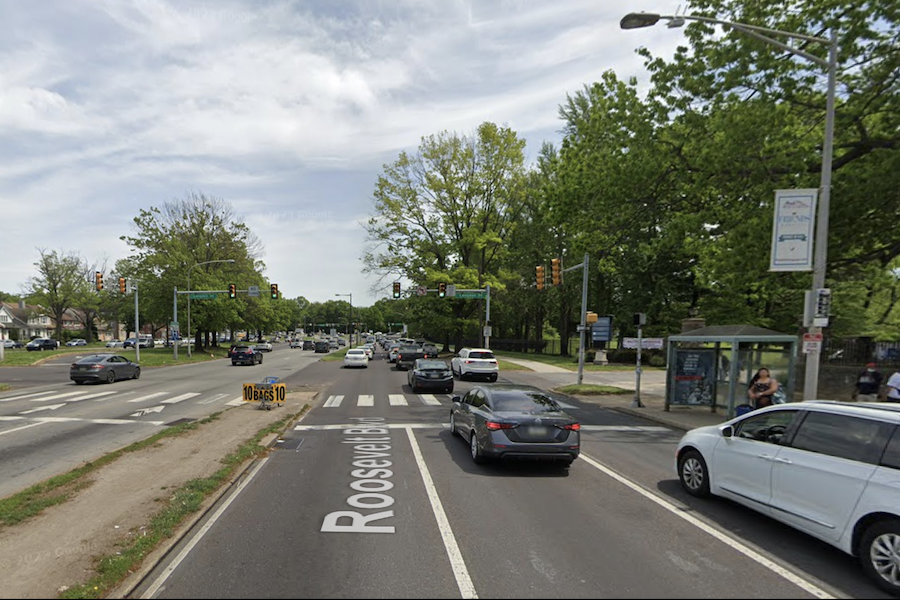The Boulevard Subway Will Be Worth Every Penny We Spend On It
PennDOT put a huge price tag on it, but no other option it studied does as much to grow ridership and reduce congestion.

The last time someone studied the Roosevelt Boulevard corridor, in 2003, the City Planning Commission recommended that the Boulevard look like this. This version has surfaced again in PennDOT’s second “Route for Change” study along with five other possible configurations. / Rendering from Philadelphia City Planning Commission
Is a subway under Roosevelt Boulevard worth it?
Previous studies conducted by the City of Philadelphia concluded it is.
And now we have another study that, while reaching no conclusions, gives us — well, at least me — reason to believe it is still.
This month, PennDOT, the city and SEPTA released draft reports describing six different ways to redesign the Boulevard, their benefits and their costs.

This drawing shows the two roadway options with a surface right-of-way for SEPTA transit. That would either be BRT or LRT. / Renderings by HNTB for PennDOT, the City of Philadelphia and SEPTA
No matter which option gets chosen, building the Boulevard subway won’t be cheap. PennDOT cost estimates for the various options run from $1.9 to $16.3 billion in 2024 dollars — though work on any of them won’t begin until 2040.
Of course, that highest figure is for the most thorough rebuild: Putting the Boulevard’s inner lanes in a covered freeway with a subway in its middle and extending the Market-Frankford Line up Bustleton Avenue to meet the subway at Bustleton and the Boulevard.
In this case, we will get what we pay for. And it will be worth it to pay more for the best.

The latest version of the expressway option calls for a smaller, four-lane road, partly in tunnel and partly in a trench.
According to the PennDOT study, a subway under the Boulevard will produce more than twice the reduction in vehicle miles traveled on it than the most optimistic projections for light rail and three-and-a-half to four times the reduction of the most optimistic BRT projection.
That’s because the subway will draw more choice riders to transit than the other modes will. The study projects that anywhere from 5,100 to 17,400 more new riders will use the subway each weekday than will use the LRT.
In terms of both congestion relief and mobility improvements, both rail alternatives outdo BRT. And average travel speed for the subway is the highest of all the options. It will take a rider only three minutes longer to get from Neshaminy Mall to City Hall on the subway than it will take that rider to get to Hunting Park subway station from there using LRT. And the LRT and BRT riders would need to transfer to a Broad Street local train there while subway riders would enjoy an express trip to Center City from Erie station.

As described in the latest Route for Change study, the subway would run on an elevated structure north of Grant Avenue (top); the neighborhood boulevard option south of there puts the trains in a tunnel under a linear park (bottom). / Rendering by HNTB for PennDOT, the City of Philadelphia and SEPTA
Besides, the subway may not cost as much as PennDOT’s study says it will. According to Penn city planning doctoral student Jay Arzu, Mr. Build-the-Boulevard-Subway, the $16 billion figure includes a 40 percent contingency for potential cost overruns. He estimates the subway’s actual cost as closer to $8 billion. And new methods for building cut-and-cover subway tunnels could bring those construction costs down.
Although I argued in 2013 that PennDOT should turn the Boulevard’s inner lanes into the freeway everyone treats them as, the neighborhood boulevard proposal offers as many if not more benefits for pedestrians, bicyclists, transit users and Boulevard residents. But either it or the capped freeway are an improvement over what’s there now. And both would function much better for everyone with subway trains running under the Boulevard — not to mention the greater potential the subway offers for reshaping development along it.

While all of the options will make the Boulevard better than this, the subway will take more of those cars off the road. / Google Street View image
What comes now is a round of community meetings to get feedback. Three have already taken place, but one more remains: on January 7th at 6 p.m. at the American Heritage Federal Credit Union (2068 Red Lion Road). Russian and Chinese interpreters will attend the January 7th meeting.
If you can’t make the meeting, you can learn all about the alternatives, access the reports and fill out an online survey at PennDOT’s “2040 Alternatives to Transform the Boulevard” website. The survey will be available on the PennDOT website through February 7th.
After the meetings and the survey, PennDOT will narrow the options from six to three, followed by two more rounds of community outreach and feedback in the spring and fall. After those, PennDOT intends to announce the preferred alternative sometime around the end of 2025.
I encourage you to make your voice heard on this transformational project as it proceeds through the meat grinder. I also hope you will join me in letting PennDOT know that when it comes to improving the Boulevard, it should settle for nothing less than the best. It will be worth every penny we pay for it — and we will have enough time to find those pennies as well.


